A white picket fence, two-car garage and grade-A schools are no longer enough to sway today’s discerning homebuyers. If you’re in the market for a new home, your focus is likely on lower utility and maintenance costs, greater comfort and, naturally, a home that will appreciate in value over time.
A National Association of Home Builders’ survey from 2021 revealed that 57% of prospective home buyers are willing to pay extra for a home if it will save them at least $1,000 a year on utility costs. When you’re looking for four walls to call your own, these seven features can have the greatest impact on your long-term investment.
1. Economical Heating and Cooling
Heating and cooling costs account for nearly half of your utility bill. Although a solar heating system would be the most efficient, it’s still a pretty rare find, and it’s often expensive. No matter what heating and cooling system is installed in a home, look for insulated ducts and a programmable thermostat.
You could also add a smart thermostat after moving in. Smart thermostats are an investment, but their clever features make them worth the money. Many models allow you to track your energy usage throughout the day so you can find ways to cut it down, and some models even offer remote control from your phone. By taking advantage of these features, you can easily optimize the energy efficiency of your heating and cooling system.
2. Insulated Air Ducts
According to Energy Star, leaks and holes in the duct system are responsible for about 20% of a home’s air loss. This loss can increase utility costs and affect the temperature of your home.
Insulated or sealed air ducts will help prevent this significant loss of energy and keep air temperature consistent and comfortable throughout the entire house. Ask your real estate agent to provide you with information on a house’s ducts, including whether they’re insulated, blocked or open. It may not be the first feature you look for when touring a home, but this sneaky energy waster is well worth a peek at before purchasing.
3. Solid Walls
In addition to the air ducts and windows, walls should be properly insulated to avoid heat lost through drafty spots. Eyeing a 1920s Dutch Colonial? It may look sweet and charming on the outside, but its walls are most likely cavity walls. As the name implies, cavity walls have a hollow space between a sheet of brick and a sheet of concrete. Unless the previous homeowner made updates, there might not be insulation in these walls. Ask your real estate agent for more information about the house before making any moves to purchase.
4. Proper Water Drainage
Home Energy Rating System (HERS), a nationally recognized energy performance rating system, suggests checking how a home manages the flow of water. Angled drainpipes and graded landscaping should direct water away from the home to prevent damage to the walls, roof and foundation. Additionally, see if the home’s landscaping allows the yard to drain properly. Standing water can damage your yard and breed mosquitoes and other pests, which can harm the land surrounding the house.
Keeping moisture out of a home can help secure the air quality inside. These measures also protect the integrity of the home’s insulation and HVAC system, so they can continue to run effectively and efficiently.
5. Energy Star Appliances
According to a study conducted by the National Association of Home Builders, the majority of homebuyers are willing to pay more upfront to save more money on energy costs later. Installing energy-efficient appliances is an excellent way to improve the efficiency of an existing home.
Energy Star is a government-endorsed certification that marks products and buildings as energy-efficient. For example, an Energy Star-certified washing machine uses 50% less water than its conventional counterpart. From refrigerators to bathroom ventilation fans, all Energy Star-certified appliances use less energy and save you more money.

6. Sealed Windows and Doors
Drafty windows and doors can make your energy bill skyrocket. When touring a home, make sure you ask your real estate agent what materials the windows and doors are made of and how they’re sealed.
If you love a home but find the windows aren’t as airtight as you’d like, you can solve this problem using any of the following methods:
- Weatherstripping
- Caulking
- Using door snakes
- Adding curtains or shades
- Applying a window film
- Adding storm windows
By effectively sealing your openings, you can increase any home’s energy efficiency without needing to go out and buy a whole new set of windows.
7. Window Films
On average, a home loses about 30% of its heating energy through its windows. Using energy-saving window treatments like films can significantly reduce home energy costs by filtering the amount of natural light that can pass through your windows. With less light entering the building, you won’t need to use as much energy for cooling as you normally would. In the winter, a window film can help to keep heat in the building, which can slash your heating bill.
In general, reflective window films are more effective than colored or transparent ones, but newer models have become better at filtering light while maintaining a neutral appearance. Madico’s window films are Energy Star-certified and come in a wide range of high-performing colors to suit every home.
About Madico Window Films
In addition to contributing to a home’s energy efficiency, window films can be beneficial to your health and well-being.
Other benefits of installing Madico window films include:
- Better scratch and crack prevention.
- Improved privacy.
- Increased comfort in your home.
- Reduced glare.
- Elevated appearance of your windows.
- Higher resale value.
All our window films, from residential to automotive, have a manufacturer’s warranty in North America. You can trust Madico to provide the best energy-saving window treatments for your home.
Maximize Your Home’s Efficiency With Madico Window Films
Looking for an easy, beautiful way to save energy in your new home? Madico’s window films are an excellent choice. Use our online tool to find a Madico dealer near you. You can also use our film selector to get an idea of which product would be best for your needs.
See Also: Tools for Monitoring Home Energy Usage


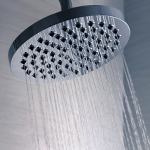 Nearly half of water consumed in a home comes from the bathroom. Conserve water simply by switching from baths to showers. The average bath uses 35-50 gallons of water, whereas a 10-minute shower uses 25 gallons. Change your showerhead to a low-flow fixture of -2.5 gallons per minute, and you’ll save up to $145 per year on electricity, too.
Nearly half of water consumed in a home comes from the bathroom. Conserve water simply by switching from baths to showers. The average bath uses 35-50 gallons of water, whereas a 10-minute shower uses 25 gallons. Change your showerhead to a low-flow fixture of -2.5 gallons per minute, and you’ll save up to $145 per year on electricity, too.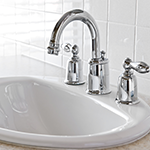 At the sink, it pays to turn off the faucet when brushing teeth, shaving, or washing your face. Take a Saturday to fix a leaky faucet. A hot water leak can add $40 to yearly costs. One of the most cost-effective conservation measures is to install a faucet aerator. Aerators lower flow by adding air to the spray and for a few dollars, you can save 4-7% of total water consumption.
At the sink, it pays to turn off the faucet when brushing teeth, shaving, or washing your face. Take a Saturday to fix a leaky faucet. A hot water leak can add $40 to yearly costs. One of the most cost-effective conservation measures is to install a faucet aerator. Aerators lower flow by adding air to the spray and for a few dollars, you can save 4-7% of total water consumption. Bathroom lights are one of the most used light sources in the home, so turn them off when leaving the room! Vanity lighting is pretty but requires a lot of energy. Make the switch to ENERGY STAR qualified compact fluorescent bulbs (CFLs). They provide quality bright lighting, use 10-50% less energy, and last 25 times longer than incandescent bulbs.
Bathroom lights are one of the most used light sources in the home, so turn them off when leaving the room! Vanity lighting is pretty but requires a lot of energy. Make the switch to ENERGY STAR qualified compact fluorescent bulbs (CFLs). They provide quality bright lighting, use 10-50% less energy, and last 25 times longer than incandescent bulbs.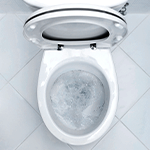 More than 25 percent of water used in the home is for the toilet. Older models use up to five gallons of water per flush, but high-efficiency toilets cut usage to 1.6 gallons. Dual-flush toilets have two flush buttons: a 1.6 gallon flush for solids and 0.9 for liquids, saving 50% of water used per flush. Water displacement devices like a brick or water bottle can work in the short-term, but be aware they may cause damage to the flushing mechanism. To test if you have a leaky toilet add a few drops of food coloring to the tank, and wait 15 minutes. If the dye appears inside the bowl, you have a leak to fix.
More than 25 percent of water used in the home is for the toilet. Older models use up to five gallons of water per flush, but high-efficiency toilets cut usage to 1.6 gallons. Dual-flush toilets have two flush buttons: a 1.6 gallon flush for solids and 0.9 for liquids, saving 50% of water used per flush. Water displacement devices like a brick or water bottle can work in the short-term, but be aware they may cause damage to the flushing mechanism. To test if you have a leaky toilet add a few drops of food coloring to the tank, and wait 15 minutes. If the dye appears inside the bowl, you have a leak to fix.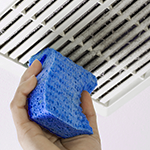 Moisture causes more than mold. It can shorten the lifespan of lightbulbs and produce larger problems in attics and your overall structure. Make sure your bathroom fan is vented to go outside and not into upper home areas.
Moisture causes more than mold. It can shorten the lifespan of lightbulbs and produce larger problems in attics and your overall structure. Make sure your bathroom fan is vented to go outside and not into upper home areas.









 Most people have a hard time getting their heads around something as abstract as a carbon unit. To paint a clearer picture of your carbon footprint,
Most people have a hard time getting their heads around something as abstract as a carbon unit. To paint a clearer picture of your carbon footprint,  According to
According to 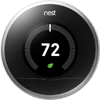 Nest takes programmable thermostats to a new level, according to the product’s website: it learns your heating and cooling habits after a few days, and then automatically adapts to those preferences to help you save energy.
Nest takes programmable thermostats to a new level, according to the product’s website: it learns your heating and cooling habits after a few days, and then automatically adapts to those preferences to help you save energy. Consumer Reports
Consumer Reports The Nest thermostat is one example of the increase in popularity of smart technology in programmable thermostats. With nearly half of your monthly energy bills coming from heating and cooling, there’s great potential to save money with these types of devices. The Nest may be one option worth your consideration.
The Nest thermostat is one example of the increase in popularity of smart technology in programmable thermostats. With nearly half of your monthly energy bills coming from heating and cooling, there’s great potential to save money with these types of devices. The Nest may be one option worth your consideration.




 Basements are a common place for significant air leaks. If you have an unfinished basement or crawlspace, look for spider webs. If there is a web, there is a draft. Inspect vents, ducts, pipes, and electrical wires that lead to the outside. The Department of Energy recommends sealing small gaps with caulk, filling holes with spray foam, and covering large holes with spray foam and foamboard. Seal air ducts with mastic or foil tape and avoid cloth-backed, rubber adhesive. Be sure not to cover any of the vents for combustion appliances.
Basements are a common place for significant air leaks. If you have an unfinished basement or crawlspace, look for spider webs. If there is a web, there is a draft. Inspect vents, ducts, pipes, and electrical wires that lead to the outside. The Department of Energy recommends sealing small gaps with caulk, filling holes with spray foam, and covering large holes with spray foam and foamboard. Seal air ducts with mastic or foil tape and avoid cloth-backed, rubber adhesive. Be sure not to cover any of the vents for combustion appliances. Basements are particularly susceptible to poor insulation, and a large amount of heat can be lost from an uninsulated basement. While insulating the basement ceiling or floor is a less intensive project, you’ll get better energy savings by adding insulation to the walls. Hire a certified professional to determine if you need interior or exterior insulation, estimate the return on investment, and install it properly to help avoid moisture issues later.
Basements are particularly susceptible to poor insulation, and a large amount of heat can be lost from an uninsulated basement. While insulating the basement ceiling or floor is a less intensive project, you’ll get better energy savings by adding insulation to the walls. Hire a certified professional to determine if you need interior or exterior insulation, estimate the return on investment, and install it properly to help avoid moisture issues later.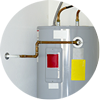 If the water heater or washer/dryer is located in the basement, check if it’s time to upgrade to newer, more energy-efficient models. Insulate your water heater, as well as ducts and hot water pipes that pass through unheated areas of the basement. If you have a little-used old refrigerator or freezer in the basement, unplug it until it is needed.
If the water heater or washer/dryer is located in the basement, check if it’s time to upgrade to newer, more energy-efficient models. Insulate your water heater, as well as ducts and hot water pipes that pass through unheated areas of the basement. If you have a little-used old refrigerator or freezer in the basement, unplug it until it is needed. Make sure your attic is ventilated properly. In the summer, some attic power fans can draw cool conditioned air out of the house and pull in warm air into the house, causing your A/C unit to work harder. In the winter, decrease heat loss by covering your exhaust fan using a box to seal around the duct where it opens into the attic. Check that your vents are not blocked by insulation or later construction.
Make sure your attic is ventilated properly. In the summer, some attic power fans can draw cool conditioned air out of the house and pull in warm air into the house, causing your A/C unit to work harder. In the winter, decrease heat loss by covering your exhaust fan using a box to seal around the duct where it opens into the attic. Check that your vents are not blocked by insulation or later construction. The attic is another location known for considerable air leakage, adding sometimes hundreds of dollars to your energy bills. Caulk wire holes and exteriors of windows and door frames, and seal around electrical boxes, air ducts, and returns. Pull-down attic stairs can be a huge source of air leakage so be sure the access door is properly sealed with weather-stripping and that it closes tightly.
The attic is another location known for considerable air leakage, adding sometimes hundreds of dollars to your energy bills. Caulk wire holes and exteriors of windows and door frames, and seal around electrical boxes, air ducts, and returns. Pull-down attic stairs can be a huge source of air leakage so be sure the access door is properly sealed with weather-stripping and that it closes tightly. Once you’ve finished air sealing, adding insulation to an unheated attic can make a big difference on energy savings, especially if you have hot or cold ceilings or uneven temperatures between rooms in the house. Check if you can see your ceiling joists. If so, it’s likely you need additional insulation.
Once you’ve finished air sealing, adding insulation to an unheated attic can make a big difference on energy savings, especially if you have hot or cold ceilings or uneven temperatures between rooms in the house. Check if you can see your ceiling joists. If so, it’s likely you need additional insulation.